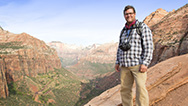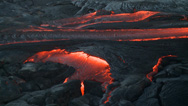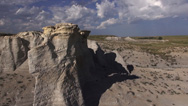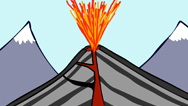How Panama Changed the World
- By Ari Daniel
- Posted 11.12.15
- NOVA
First there were violent volcanic detonations. Then those volcanoes traveled across a sea. And finally Panama came to be, which altered the face of the planet as we know it.
Transcript
Kirk: What do Hawaii and Panama have in common? One’s an isolated string of dots in the middle of the Pacific. The other is a slender connector of two continents. The two places are 5000 miles apart, and yet—curiously—they have a very similar origin story. A story that explains the biodiversity and climate across a vast stretch of the planet.
But first, we need to get our hands on some rocks in Panama. And not just any rocks.
Class: When we want to study the interior of the Earth, we have the problem that we don’t get directly to it. We cannot directly sample it because it’s too hot, it’s too deep, we cannot drill into it. So we have to rely on volcanic rocks that come to us to the surface.
Kirk: The first mineral to crystallize out of that molten volcanic mass is a green one called olivine. Find olivine, and it’s like catching a glimpse of the interior of the Earth, and the forces that helped shape the landscape we see today.
But finding the right rocks takes a lot of work. Class and Gazel have to visit beach… after beach… after beach. It takes the better part of a day, but finally…
Gazel: And look, the sand is full of olivine.
Class: Oh look, there’s one! Wow. Look at that, beautiful.
Gazel: Great. And look at the sand – the sand is all full with olivine.
Class: Oh yeah, it’s so green.
Gazel: This is excellent.
Class: We’re in the right spot.
Gazel: This is the way that rock looks inside. It’s full of the green mineral olivine. A lot of things happened since this rock was formed many million years ago.
Kirk: And here’s what that olivine can tell us about those happenings. Many of the rocks on this beach, and elsewhere in Panama, were actually formed far from here.
Gazel: In the place where the Galápagos Islands are today by this thermal anomaly we call the Galápagos plume.
Kirk: This is where we get to how Panama and Hawaii are alike. A plume is a mass of superheated rock that rises from the mantle—the layer of Earth between the crust and the core—and heads to the surface. Over time, as the overlying crust moves, a string of volcanoes form. This is how Hawaii was made. And it’s how the area that would become Panama was made as well, somewhere between 5 and 15 million years ago. Out by the Galápagos, a mantle plume created a series of volcanic islands. As the plate they were riding on moved to the northeast, they eventually collided with a different string of volcanoes already dotting the water between North and South America.
Class: The sea mounts and islands from the Galápagos plume were accumulated and eventually closed up the isthmus of Panama, and closed up the ocean current.
Kirk: That is, what had been a free flow of water between the Pacific and Atlantic Oceans was now sealed off.
Class: And it’s very amazing that something as deep as a mantle plume could change something as significant as ocean circulation.
Kirk: Not to mention a complete redistribution of biodiversity across two continents. Once the Panama we know today came into existence, a land bridge was formed, allowing animals from North America to walk, slither, and gallop into South America, and vice versa.
Panama has had a lasting impact on the life forms and climate of the Earth.
Gazel: Oh my god, look at this.
Class: Ok, let’s take it quick.
Gazel: It’s so beautiful! This is incredible. This is a great sample.
Class: This is it.
Credits
PRODUCTION CREDITS
- Writer and Editor
- Ari Daniel
- Producer and Director
- Joe Myerscough
- Assistant Producer
- Carl Akkouh
- Narration
- Kirk Johnson
- Original Footage
- © WGBH Educational Foundation 2015
MEDIA CREDITS
- Motion Graphics
- Duane Dobbels/Skypunch Creative
Fluid Pictures
IMAGE
- (main image: Panama beach)
- © WGBH Educational Foundation 2015
Related Links
-

Making North America
Host Kirk Johnson explores how the continent was shaped—and how it shaped us.
-

A Labyrinth of Lava
The big island of Hawaii is shot through with an underground labyrinth carved out by lava.
-

Towers of Chalk in Kansas
Amidst the flat plains of Kansas are the gorgeous remains of an ancient inland sea.
-

Meet the Volcanoes
Volcanoes can come in many shapes and sizes.

